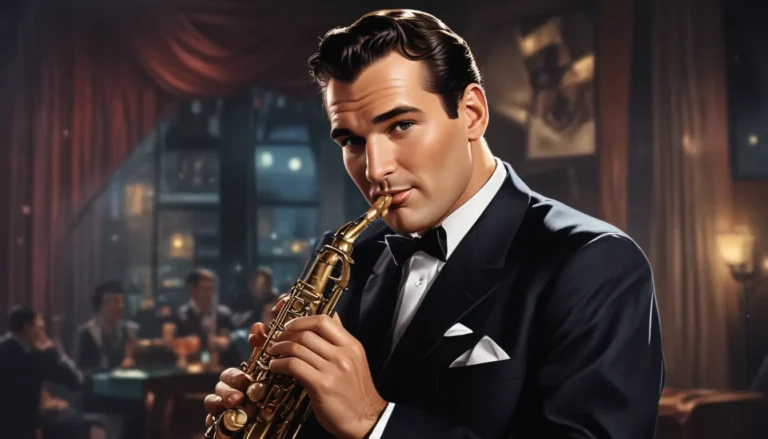The images in our articles may not match the content exactly. They are used to grab your attention, not to show the exact details in the text. The images complement the text but do not replace it.
Coleman Hawkins, the iconic jazz saxophonist known as the “Father of the Tenor Sax,” has left an indelible mark on the history of jazz with his powerful sound and innovative playing style. Let’s dive into 18 fascinating facts about this legendary musician, shedding light on his life, career, and lasting impact on the world of jazz.
Coleman Hawkins: A Jazz Pioneer
Coleman Hawkins was born on November 21, 1904, in St. Joseph, Missouri, where he discovered his passion for music at an early age. While he initially started playing the piano, it was his switch to the tenor saxophone that defined his groundbreaking career in jazz.
Hawkins rose to fame as a member of Fletcher Henderson’s band, where he played a crucial role in popularizing the saxophone as a lead instrument in jazz. His distinctive tone and innovative improvisational skills quickly earned him the nickname “Bean” and established him as a pioneer of the tenor saxophone.
The Masterful Musician
One of Coleman Hawkins’ most enduring legacies is his recording of “Body and Soul,” considered a masterpiece in the world of jazz. This iconic rendition showcases Hawkins’ technical prowess and emotional depth, solidifying his reputation as a virtuoso in the genre.
Throughout his illustrious career, Hawkins collaborated with jazz legends such as Louis Armstrong and Duke Ellington, leaving a lasting impact on the evolution of jazz music. His influential role in the development of the bebop style and his continuous evolution of his playing style highlight his dedication to pushing the boundaries of his art.
Touring the World and Leaving a Legacy
Hawkins’s impact extended beyond the borders of the United States, as he toured extensively around the world, introducing jazz to international audiences in major cities like Paris and London. His vast discography reflects his remarkable talent and versatility as a musician, earning him numerous accolades and awards for his contributions to jazz.
In 1992, Coleman Hawkins was posthumously awarded the Grammy Lifetime Achievement Award, recognizing his enduring impact on the world of music. His influence can still be heard in modern jazz, inspiring contemporary saxophonists and shaping the evolution of the genre.
Remembering a Jazz Icon
Coleman Hawkins’ legacy as a true pioneer of jazz and a master of his craft lives on through his timeless recordings and lasting contributions to the genre. His innovative techniques, expressive playing style, and unwavering commitment to musical excellence set him apart as a trailblazer in the world of jazz.
As we reflect on these 18 fascinating facts about Coleman Hawkins, we are reminded of the immense talent and impact that he had on the world of music. His dedication to pushing the boundaries of jazz and his unwavering passion for his art continue to inspire musicians of all generations.
FAQs: Exploring Coleman Hawkins
-
Who was Coleman Hawkins?
Coleman Hawkins was a renowned jazz musician known for his contributions to the development of the tenor saxophone as a solo instrument. -
What is Coleman Hawkins’ signature sound?
Hawkins had a rich and distinctive tone on the tenor saxophone, characterized by its warm, full-bodied sound and expressive phrasing. -
What are some of Coleman Hawkins’ most famous recordings?
Some of his most notable recordings include “Body and Soul,” “Picasso,” and “The Hawk Flies High.” -
Who were some of Coleman Hawkins’ musical influences?
Hawkins drew inspiration from early jazz pioneers such as Louis Armstrong and Jelly Roll Morton, as well as classical composers like Igor Stravinsky. -
What was Coleman Hawkins’ impact on the jazz genre?
Hawkins played a crucial role in popularizing and expanding the influence of jazz, particularly through his innovative improvisation and breakaway from traditional Dixieland style. -
Did Coleman Hawkins collaborate with other jazz musicians?
Yes, he collaborated with numerous jazz greats, including Duke Ellington, Benny Goodman, and Thelonious Monk. -
When and where was Coleman Hawkins born?
Hawkins was born on November 21, 1904, in St. Joseph, Missouri, United States. -
How long was Coleman Hawkins’ career?
Hawkins had a career spanning over five decades, from the 1920s to the 1960s. -
Did Coleman Hawkins receive any awards or recognition?
Yes, Hawkins received numerous awards and accolades throughout his career, including induction into the Grammy Hall of Fame and the DownBeat Jazz Hall of Fame. -
How did Coleman Hawkins influence future generations of musicians?
Hawkins’ innovative playing style and musical concepts served as a foundation for countless saxophonists and jazz musicians who followed in his footsteps.
In conclusion, Coleman Hawkins’ groundbreaking contributions to jazz continue to inspire musicians today, ensuring that his legacy as a true jazz icon will live on for generations to come. Dive deeper into the world of jazz and explore its rich history to discover the lasting impact of musicians like Hawkins on the evolution of music and popular culture.






